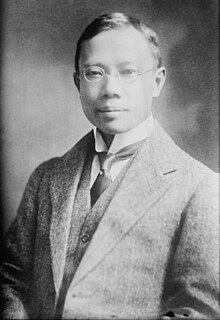Wu Lien-teh
Wu Lien-teh (born March 10, 1879 , † January 21, 1960 ; maiden name Goh Lean Tuck , alternative name Ng Leen Tuck ) was a Chinese doctor . He became known for his work in the plague epidemic in Manchuria in 1910/1911. He is considered a leading figure in the creation of modern health services in the time of the Republic of China .
Origin and career
Wu Lien-teh was born in Penang , British Malaya . His father was a goldsmith who emigrated to Malaya from China. Wu completed his secondary school in Penang and was able to study medicine in Europe thanks to a scholarship from the Krone. He began his studies in 1896 and became the first graduate of Chinese medicine from Cambridge University in 1902. He then spent a year researching at Ronald Ross's Tropical Medicine Institute in Liverpool . He then moved on to the Pasteur Institute in Paris, where he worked on malaria and tetanus .
Medical work in Asia
In 1903 he returned to Asia. There he gave lectures in Singapore and did research on beriberi in Kuala Lumpur . He then went to live in his private practice in Penang. He also supported the campaign against opium addiction in Malaya. However, he left the colony after being charged with allegedly improper use of opium. Wu was finally welcomed with open arms in China, where he was appointed vice chief of the Imperial Military Academy in Tianjin .
In this capacity he was sent by the Chinese government to Manchuria in December 1910 to fight an outbreak of the disease there. In Harbin , he found Yersinia pestis in the lung tissue of a Japanese epidemic victim removed after death. Wu achieved through modern hygiene and disease control measures, which also included the restriction of the freedom of movement of the population, to contain the epidemic, which lasted until the spring of the following year. He took over the international coordination between the neighboring powers China , Japan and Russia . In 1911 he founded the Northern China Plague Prevention Service, the country's first modern public health organization. In 1916 he became the first chairman of the newly created Medical Society of China. In 1931 he was appointed head of the National Quarantine Service by the Guomindang government.
In 1926 he published an English-language scientific treatise on pulmonary plague. The treatise remained the standard medical work on the disease until 1954, when his student Robert Pollitzer published his own monograph on the subject for the World Health Organization .
In 1931 he was briefly imprisoned by the Japanese authorities in Manchuria on suspicion of espionage. After the outbreak of the Second Sino-Japanese War , he fled to Malaya in 1937. His wife and both children died in the turmoil in China, both of disease. During the Second World War , he was kidnapped by left-wing anti-Japanese guerrillas and released for ransom. The payment in turn led to charges by the Japanese occupation authorities. This was stopped at the instigation of a Japanese officer and patient Wu.
literature
Autobiography
- Wu Lien-teh: Plague Fighter: The Autobiography of a Modern Chinese Physician. Cambridge, 1959
Individual evidence
- ↑ a b c d e f Lee KH, Wong DT, Ho TM, Ng KH. Dr Wu Lien-teh: modernizing post-1911 China's public health service. Singapore Med J. 2014; 55 (2): 99-102. doi: 10.11622 / smedj.2014025
- ↑ Ma Z, Li Y. Dr. Wu Lien Teh, plague fighter and father of the Chinese public health system. Protein Cell. 2016; 7 (3): 157-158. doi: 10.1007 / s13238-015-0238-1
- ^ Robert Peckham: Epidemics in Modern Asia. Cambridge, 2016, p. 214
- ^ William C. Summers: The Great Manchurian Plague of 1910-1911. New Haven, 2012, p. 105
| personal data | |
|---|---|
| SURNAME | Wu, Lien-teh |
| BRIEF DESCRIPTION | Chinese doctor and health official |
| DATE OF BIRTH | March 10, 1879 |
| PLACE OF BIRTH | Penang |
| DATE OF DEATH | January 21, 1960 |
